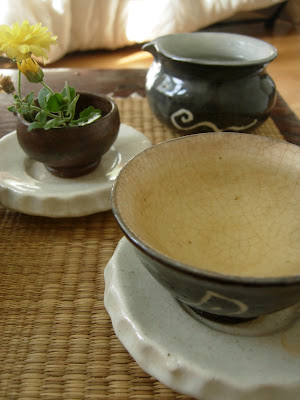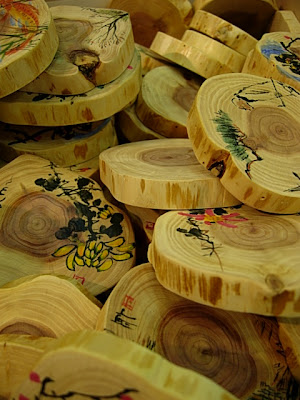
Ddok cha, simply put, is Korean cake tea. Under this definition any tea from Korea that is pressed into a cake can be classified as ddok cha. Because of such a broad definition, you may be thinking that there must be an infinite number of different sizes and styles of ddok cha. Not really. In ones experience with this type of tea there seems to be two types of ddok cha. These two types can be classified by different appearance, production, preparation, and flavour profile.

The first type is the coin/ heavily pounded type. The coin type is about the size of a fairly densely packed silver dollar coin and many are often strung together, through the middle, like the way you would picture old Chinese coins. According to Brother Anthony of Taize, this type is sometimes referred to as "yop jon cha" or cash tea.
This coin type goes through the last steps of its production by being pounded with a large wooden mallet on large wood planks or pounded mortar and pestle style using large wood logs in a large stone bowl. When the tea is reduced to a gunky pulp it is placed into moulds, dried to form, and quite often strung together. A picture of traditional moulds can be found on the bottom picture of this post by Toki of The Mandarin's Tea. Click here for a detailed video outlining the production.
The coin type ddok cha is best enjoyed the traditional way, a way very similar to the way Lu Yu describes Chinese Tang Dynasty tea in his book The Classic of Tea (circa 760-780 AD). Click on these posts on Cha Dao and A Tea Addicts Journal of attempts to make Tang tea with ddok cha.
A Korean tea roaster looks much like a ceramic Korean tea warmer. Fitting with the style of southren wares it looks very rustic and natural and usually looks almost stonelike. It is hollowed out and has a place where a tea light can be placed. On top there is a hole, into which the conical metal or sometimes ceramic piece is placed over. The cone is placed right over the tealight. Tea is added into the hollowed out cone and is roasted there. Stirring is required to distribute the roast evenly across the broken tea pieces.
After the tea has been roasted to perfection, the tea is either broken into pieces (if it hadn't been previous broken) then it is added to either a kettle (sometimes a ceramic kettle) on very light boil or it is steeped in a tea pot using water that is just off boil. After boiling in a kettle, place a clean hemp cloth over a cup or serving pot and pour the tea through the hemp cloth so that the froth and teabits are filtered out.
Its taste is spicy, medicinal, and bitter when prepared in this traditional way. Due to its tighter compression, crushed composition, and more extreme preparation, aging coin type ddok cha tastes much better as it mellows with age.

The other type of ddok cha is the larger disk/ pressed type. Usually about 100 grams of tea are pressed into a disk shape that resembles a mini bing but can also take other forms such as bell shapes or ball shapes similar to tuo cha. The compression is not as tight as the coin type ddok cha. These cakes are wrapped in traditional Korean paper and are often tied together with hay or bamboo string in groups of 3s or 5s or wrapped in bamboo leaf similar to a tong of puerh.
Unlike coin type ddok cha, disk type ddok cha doesn't get pounded to a pulp. During the last steps of its production it is either pounded lightly or pressed between large wood planks. After the right amount of tea is measured out then it is often pressed by planks into form.
The disk type ddok cha is prepared in a Korean ceramic tea pot. It is wise to not use just off boiling water for young cakes as the tea can still be a bit bitter if prepared in this manner.
Fresh disk type ddok cha tastes somewhere between a Korean yellow tea and green tea. Due to its loose compression, it ages quicker than the coin type. Its full intact leaves allow for much less bitterness and more full flavoured profile. With age this tea gets much more mellow in taste, stronger in qi, and more floral in nature.
To avoid confusion on the topic of ddok cha in the future, one believes that ddok cha should be referred to using these subtypes- coin ddok cha or disk ddok cha.
Peace






































